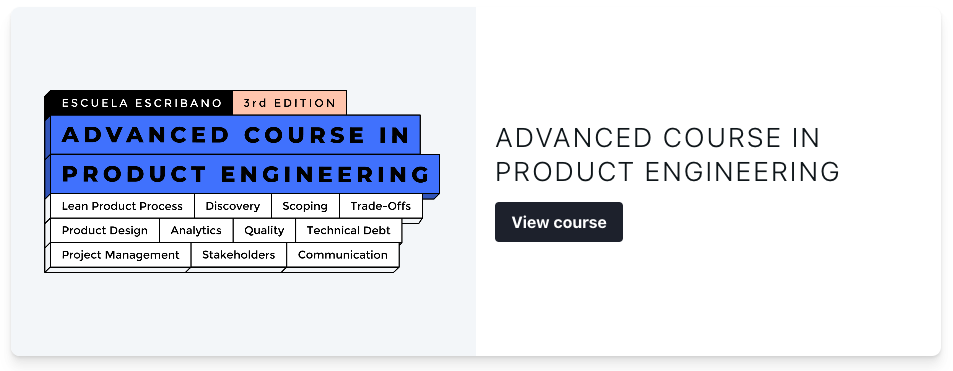
I just finished the Advanced Course in Product Engineering taught by Javier Escribano. Here’s a brief review of the course and my thoughts.
TL;DR
This course is for you if you believe technical roles can benefit from a product mindset.
Overview:
- Overall: Well-designed with extensive lectures, materials, and thought-provoking guest lectures.
- Recommended for: Individual contributors seeking better engagement with product processes and managers aiming to elevate their teams’ mindsets.
Javier, with his vast experience in product companies like Ontruck, shares insightful details that make the notes, videos, and live classes engaging. The course aims to transform traditional software engineers into Product Engineers, who play a more influential role throughout the product development lifecycle.
Product engineers contribute to product vision, strategy, and decision-making instead of merely executing tasks. This resonated with me, as I’ve always wondered why smart technical people aren’t involved in these crucial aspects. I believe good engineers are highly analytical, solve problems effectively, and design cost-effective solutions – qualities valuable to the bigger picture.
This course helped me structure ideas and intuitions I’ve already applied in my career and team. I encourage colleagues to focus on “why” rather than just “how,” while incorporating lean processes and ownership of projects. While I didn’t learn entirely new things, the course provided a formal framework for my existing approach, enabling me to better communicate my expectations and collaborate with product roles and stakeholders.
Contents
The course comprises four modules:
- Product Engineering and Product Fundamentals:
- Introduces squad fundamentals, the role of product engineering, and basic product processes.
- Discusses bad practices in squad design, such as having separate product owner, scrum master, and QA roles.
- I found the discussion on these practices particularly interesting.
- Scoping, Trade-offs, and Design Principles:
- Focuses on trade-offs due to uncertainties in product development.
- Presents scoping as a way to learn quickly.
- Discusses core and secondary features, their relationship with core technology, and complementary tools.
- I enjoyed the discussions on prototyping and user testing for validating solutions, as I’ve used prototypes extensively in my career.
- Product Analytics and Quality:
- Introduces data-driven companies, product engineers’ role with OKRs, and co-guiding the product process.
- Provides a basic introduction to KPIs for digital products.
- Explains the difference between observability and monitoring, which I found informative.
- Discusses traditional QA vs. Model Quality Assistance, introducing new concepts I hadn’t encountered before.
- The discussion on technical debt with decision-making tips was insightful.
- Project and Stakeholder Management:
- Focuses on non-technical skills for better collaboration with colleagues and stakeholders.
- Offers guidance for mid-to-senior engineers on project and stakeholder management.
- I liked the proposed best practices for cross-team collaboration, which reminded me of the lessons in Team of teams
Class Dynamics
The course follows a flipped classroom format. Students engage with primary and secondary materials (videos, readings, online resources) before class to prepare for discussions, problem-solving, and collaborative activities. I spent about six hours a week reading and reflecting on the materials.
Modules comprise readings and videos, and case study participation is optional every two weeks. Live sessions include guest lectures from professionals sharing their expertise on the module topics. I enjoyed interacting with guest experts, discussing topics with Javier and classmates, and participating in case study discussions. We shared our experiences and tackled current and past challenges.
Key Takeaways
As a data professional, the Product Engineering role resonated with me, even though I didn’t previously have a name for it. I’ve always emphasized the business/product side and embraced ownership of projects.
This course is valuable for my role. It encouraged me to consider coordination between product, tech, data, and design roles for faster, better product development. The course also provided references to promote cultural changes in my teams, ensuring data professionals are involved from the product discovery and design stages.
Beyond the educational content, the discussions with other professionals were a source of joy and excitement. It was inspiring to connect with people eager to transform their companies, teams, and themselves by embracing a more proactive product management mindset.